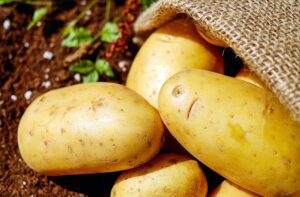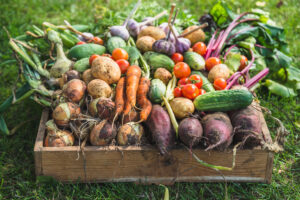Best Survival Crops to Grow

Discover the power of self-sustainability by learning what the best survival crops are! Cultivating your own garden can provide a reliable, organic food source. Embrace resilience and nourish your body in uncertain times.
Introduction
Growing survival vegetables is essential for self-sustenance, especially in uncertain times. These best survival crops can provide us with vital nutrients necessary for physical health and resistance against diseases. Furthermore, cultivating survival crops can reduce dependency on commercial grocery supply chains, and bring us closer to nature, fostering a sense of self-reliance and resilience. Finally, the process of gardening itself can be therapeutic, reducing stress and instilling a sense of accomplishment. Survival gardening is not just about survival, it’s about thriving. It’s an integral part of sustainable living and contributes to food security.
Potatoes
Potatoes are a versatile and high-yielding crop, making them a staple in survival gardening. They come in a variety of types, each with its own unique characteristics. From the hearty russet potato, great for baking and mashing, to the red and yellow potatoes, perfect for roasts and stews, there’s a potato for every meal. Potatoes are also a rich source of vitamins C and B6, potassium, and fiber, particularly when the skin is left on. They are capable of growing in different soil conditions and climates, and their underground nature makes them less susceptible to pests and weather fluctuations. Importantly, potatoes have a long storage life when kept in cool, dark conditions, ensuring a reliable food source throughout the year. For a detailed article on how to store potatoes click here.

Ideal Growing Conditions
Potatoes thrive best in well-drained, loose soil that is slightly acidic, with a pH ranging between 5.0 and 7.0. They prefer cool weather and should be planted in early spring, as soon as the soil can be worked. The planting site should receive full sun, meaning at least six hours of sunlight per day. While potatoes are relatively hardy and can tolerate a reasonable range of conditions, excessively wet, dry, or compacted soil can impede their growth and make them more susceptible to disease. Consistent watering is key, as irregular watering can lead to irregularly shaped potatoes or growth cracks. Implementing crop rotation techniques in your garden can also help prevent soil-borne diseases and maintain soil fertility.
Sweet Corn
Sweet corn is not only a delicious addition to meals, providing natural sweetness and crunch, but it also has long-term storage suitability when dried. This dehydrated form of corn can be used in soups, stews, and even ground into cornmeal for baking. It’s a rich source of fiber, vitamins B1 and B5, vitamin C, and folate. Sweet corn is also reasonably easy to grow, requiring sunny conditions and well-drained soil. One of the primary benefits of corn is its high yield; a small plot can produce a significant amount of corn for consumption. The removal of kernels from the cob and the drying process can be time-consuming, but the result is a versatile, nutritious crop that can be stored for years, making it an excellent choice for survival gardening.
Ideal Growing Conditions for Corn
Corn is a warmth-loving crop and thrives in temperatures between 60°F and 95°F, which is why it’s often planted in late spring. This plant prefers a sunny location with well-drained, fertile soil. Soil pH should ideally be in the neutral to slightly acidic range, between 6.0 and 6.8. To support the high nutrient demand of corn, the soil should be well-amended with compost or well-rotted manure prior to planting. Corn plants need approximately 1 inch of water per week, either from rain or supplemental watering, especially during the pollination period. As corn is wind-pollinated, planting in blocks rather than rows can increase pollination rates and improve kernel development. Proper spacing is also crucial; corn plants should be spaced about 12-18 inches apart in rows 30-36 inches apart to allow for adequate light penetration and air circulation.
Carrots
Carrots are another ideal crop for survival gardening due to their nutritional value and long storage life when properly preserved. They are a rich source of beta carotene, fiber, vitamin K1, and antioxidants.
Ideal Growing Conditions
Carrots prefer cool weather and thrive best in loose, sandy soil. Deep, well-drained soil is ideal as it allows the carrots to grow straight and long. Carrots need a pH ranging from 6.0 to 7.0, and they should receive full sun or partial shade. Consistent moisture is essential for the growth of carrots; therefore, they should be watered regularly, especially during dry spells. Carrots are a biennial crop, which means they flower and produce seeds in their second year. However, they are usually grown as an annual crop for their tasty roots. The roots can be harvested when they are brightly colored and 1 inch in diameter. Proper storage involves cutting off the tops to about an inch above the roots and storing them in a cool, humid environment.
Beans
Beans come in a wide variety of shapes, sizes, and colors, each with its unique flavor and texture. Some of the common types include pinto, black, kidney, and navy beans. They are high in protein and fiber, presenting a perfect storage food packed with essential nutrients. With proper storage in a cool, dark, and dry place, dried beans can last for years while retaining their nutritional value.
Ideal Growing Conditions
Beans are also relatively easy to grow, making them a popular choice for home gardens. They prefer full sun and well-drained soil. Depending on the variety, beans can be bush types, which are more compact, or pole types, which will climb and require support. Beans should be planted after the danger of frost has passed and the soil has warmed, usually late spring or early summer. For a continuous harvest, plant additional seeds every two weeks.
Harvesting beans is a straightforward process. They are usually ready for picking 55 to 60 days after planting. Regular harvesting encourages the plant to produce more beans. After harvesting, make sure to dry them completely before storage to prevent any potential spoilage or mold growth.
For a detailed article on how to store beans long term check here.
Kale
Kale, a nutritional powerhouse, is known for its myriad health benefits. Packed with vitamins A, C, and K, it is an excellent source of antioxidants and dietary fiber. Furthermore, this leafy green vegetable is rich in minerals like calcium, iron, and potassium. Its high nutrient content makes it a favorite among health-conscious individuals.
Ideal Growing Conditions
Kale is a cold-weather crop, which means it grows well in cooler conditions and can tolerate frost, making it suitable for fall or early spring planting. It requires well-drained, fertile soil with a pH between 6.0 and 7.5. Full sun exposure is ideal, but kale can also grow in partial shade. Regular watering is important to maintain moist soil, but be careful not to overwater as this can lead to root diseases. Kale plants can be harvested when the leaves are about the size of your hand. To promote continuous growth, only pick the outer leaves, allowing the center of the plant to continue producing.
Tomatoes
Tomatoes are versatile fruits, cherished globally for their vibrant color, juicy texture, and appetizing tang. They can be consumed raw, cooked, or processed into sauces, juices, and pastes, making them a staple in a multitude of cuisines. A rich source of vitamins A and C, tomatoes provide notable health benefits. They contain lycopene, a powerful antioxidant known to promote heart health and potentially ward off certain types of cancers.
For long-term preservation, tomatoes are best canned or made into a sauce and then frozen. Canning preserves the freshness and nutritional value of the tomato, while allowing one to enjoy their summery goodness even in the heart of winter. To can tomatoes, one needs to blanch them to remove the skins easily, pack them into jars with some lemon juice to ensure safe acidity levels, and then process in a water bath canner.
Ideal Growing Conditions
Tomatoes thrive in well-drained soil with a pH level between 6.2 to 6.8. They require ample sunlight, so select a spot that gets a minimum of 6 hours of direct sun daily. Starting seeds indoors 6 weeks before the last expected frost date can give a head start to the growing season. Once the plants are about 3 feet tall, remove the leaves from the bottom 1 foot of stem to allow better air circulation and reduce the chances of disease. Regular watering, proper staking, and timely application of organic fertilizer can significantly enhance the yield.
Zucchinis
Zucchinis, also known as courgettis’, are a summer squash known for their mild flavor and versatile culinary uses. Their high water content makes them low in calories, while still being rich in essential nutrients like potassium, manganese, and vitamins C and K. Zucchinis can be eaten raw, stir-fried, grilled, stuffed, or baked into bread.
Ideal Growing Conditions
Zucchinis thrive in warm, frost-free weather and well-drained soil with a pH between 6.0 and 7.5. They are ideally planted in the late spring or early summer when soil temperatures have consistently reached 70°F. Zucchini plants require full sun and regular watering but avoid wetting the leaves to prevent fungal diseases. Zucchinis are typically ready to harvest 6 to 8 weeks after planting when they are about 6 to 8 inches long and the skin is still soft. To encourage more productive plants, regularly pick zucchinis when they are young and tender.
Peppers
Peppers, belonging to the Capsicum genus, offer a wide variety of flavors, colors, and heat levels, making them an integral part of many cuisines worldwide. From the mild bell peppers with their sweet, crisp flavor to the fiery hot habaneros, there’s a pepper to suit every palate. Rich in vitamins A and C, peppers not only add zest to your meals but also contribute to your daily nutritional intake. They can be consumed raw, grilled, roasted, or incorporated into sauces, salads, and stir-fries.
For preservation, peppers can be dried, canned, or frozen. Drying peppers intensify their flavor and heat, making them perfect for creating spice blends or adding a kick to your dishes. Canning peppers, usually in the form of pickling, allow you to enjoy their crunchy texture throughout the year. Freezing, on the other hand, retains the fresh flavor of peppers, although the texture may become somewhat softer after thawing.
Ideal Growing Conditions
Cultivating peppers can be a gratifying experience provided you follow the right strategies. They need warm soil, so it’s best to start seeds indoors about 8-10 weeks before the last spring frost date. Once the seedlings have developed two true leaves, they can be transplanted to larger pots. Transfer the plants to your garden when night temperatures consistently stay above 55°F, spacing them about 18 to 24 inches apart. Peppers require full sun and thrive in well-draining soil with a pH between 6.2 and 7.0. Regular watering, proper fertilization, and timely pest control are critical to ensure a bountiful harvest.
Beets
Belonging to the Beta Vulgaris species, beets present a wide range of varieties, each with its unique color, taste, and nutritional profile. The most common type is the red beet, known for its deep crimson color and earthy flavor. Golden beets offer a sweeter taste and vibrant yellow hue, while Chioggia beets, also known as candy cane beets, surprise with their red and white concentric circles when sliced. Beyond the root, beet greens are also highly nutritious and can be prepared much like spinach or Swiss chard.
Beets are versatile in the culinary world. They can be roasted, boiled, pickled, or enjoyed raw in salads. Their natural sweetness makes them a popular component in juices and smoothies, while their robust flavor enhances stews and soups. Beet greens, with their slightly bitter taste, provide a delicious contrast in salads, stir-fries, and grain bowls.
Ideal Growing Conditions
Cultivating beets requires a few key considerations. They prefer cool weather and can be planted in the early spring or late summer. Beets grow best in loose, well-drained soil with a pH between 6.0 and 7.0. They need ample space to expand, so thin seedlings to about 2 to 3 inches apart once they are 4 inches tall. Keep the soil consistently moist, but avoid overwatering to prevent root rot. Beets are usually ready to harvest when they are approximately the size of a golf ball, usually 45-65 days after planting. Remember, the smaller they are at harvest, the tenderer and sweeter they’ll be. Don’t discard the leafy greens; harvest them throughout the growing season and use in your favorite recipes.
Winter Squash
Winter squash encompasses a diverse group of varieties, each boasting its distinct color, flavor, and texture. Acorn, butternut, spaghetti, and Hubbard squashes are among the most popular. Acorn squash has a sweet, nutty flavor perfect for roasting or stuffing. Butternut squash, with its creamy texture, is versatile, finding its way into soups, salads, and even desserts. Spaghetti squash, when cooked, yields spaghetti-like strands, providing a healthy, low-carb alternative to traditional pasta. Hubbard squash, known for its blue-grey skin and bright orange flesh, is often pureed for pies and soups.
These squashes excel in terms of long-term storage suitability. Their hard rind allows them to be stored for several months in a cool, dark place, making them an excellent source of vitamins and minerals during the winter months when fresh produce is scarce.
Ideal Growing Conditions
Cultivating winter squash requires some care. Start seeds indoors about a month before the last spring frost or directly outdoors once the danger of frost has passed. Provide ample space for their sprawling vines, or train them on a sturdy trellis to maximize vertical space. Squashes prefer full sun and well-drained soil enriched with organic matter. Regular watering and periodic feeding with a high-potassium fertilizer will promote healthy growth and prolific fruiting. A layer of mulch can help retain soil moisture and keep weeds at bay. Monitor plants regularly for pests and diseases, and employ organic control measures as needed. Harvest squash when the rind is hard and fully colored, and cure in a warm, well-ventilated area for 10-14 days to enhance storage life.
Cabbage
Cabbage is a leafy vegetable available in several varieties, each with its unique taste and texture. Green cabbage, with its firm and dense head, is probably the most recognized type, ideal for coleslaw and stir-fries. Red cabbage, characterized by its purple-red leaves, is excellent for salads and pickling. Savoy cabbage, having curly and tender leaves, is perfect for wraps and stews.
The robust nature of cabbage makes it suitable for long-term storage. Kept in a cool, dark place with good air circulation, it can be stored for up to two months. However, once cut, it should be used within a few days to maintain its freshness.
Ideal Growing Conditions
Cultivating cabbage requires a sunny spot and well-drained, fertile soil with a pH between 6.0 and 7.0. Plant the seeds ¼ to ½ inch deep in the soil, spaced about 12 to 24 inches apart, depending on the variety. Regular watering is crucial, but avoid soaking the head of the cabbage to prevent rot. Cabbages are typically ready to harvest in about 70-95 days.
Spinach
Spinach is a nutrient powerhouse, packed with essential vitamins and minerals such as iron, calcium, magnesium, and vitamins A, C, and K. Besides its high nutrient content, it is low in calories, making it an excellent choice for those aiming for a balanced diet.
Ideal Growing Conditions
Growing spinach is relatively simple, as it can adapt to many soil types, though it prefers well-drained soil rich in organic matter. It also favors cool weather and does well in full sun to partial shade. Spinach seeds should be planted about 1/2 inch deep, spaced 2 to 3 inches apart. It requires consistent watering, but be careful to not overwater as this can lead to root rot.
Spinach typically matures and is ready for harvest in about 6 weeks. By cutting the leaves at the base, new leaves will sprout, offering a continuous yield throughout the season. Proper care and timely harvesting will ensure a healthy spinach crop, providing abundant nutritional benefits.
Peas
Peas are a valuable addition to your home garden due to their nutritional profile. They are rich in proteins, fiber, vitamins A, C, K, B vitamins, and minerals like iron, potassium, and magnesium. It is also interesting to note that peas are low in calories, which makes them a healthy choice for those watching their weight.
Ideal Growing Conditions
Growing peas is quite straightforward. They prefer a cool climate and do well in well-drained soil. Peas should be planted 1 to 1.5 inches deep and about 2 inches apart in the row. As peas thrive in cool temperatures, early spring or late summer is the ideal time to plant them. They need support to grow, so ensure a trellis or some type of support system is set up when the plants are about 6 inches tall. Regular watering is necessary but avoid overwatering as peas do not like waterlogged soil. With proper care, peas can typically be harvested around 60 to 70 days after planting.
Conclusion
Growing these vegetables is not only straightforward but also provides an organic, reliable food source. Growing your own food, like offers a pathway to self-sustainability, a valuable practice in today’s uncertain times. Cultivating your own garden not only ensures a supply of fresh produce, but it also fosters a sense of self-reliance and resilience in the face of unpredictable circumstances. The importance of these qualities cannot be overstated, particularly in our current global climate.

